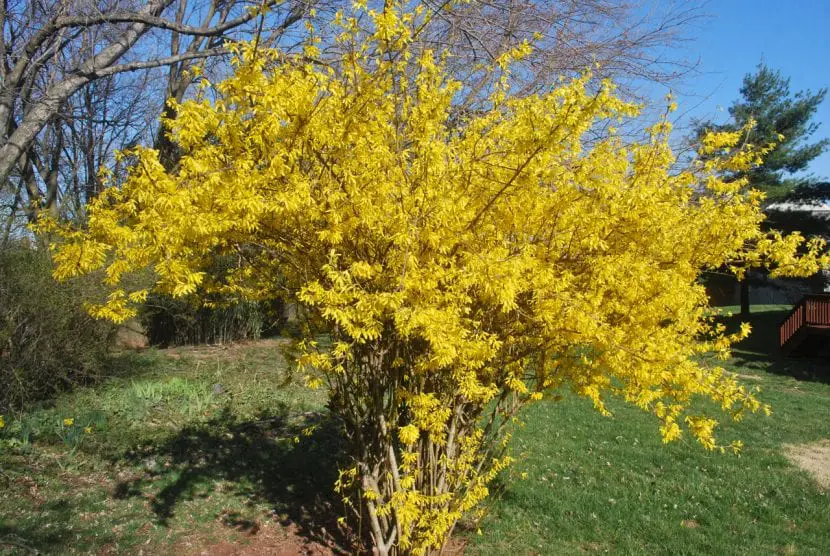
Forsythia is a perfect shrub to have in gardens and in pots. It is one of the first plants to flower, which it does wonderfully. It produces so many flowers that its branches are practically hidden behind its petals. And the best part is that it makes it almost effortless.
It does not require much maintenance, so I can tell you with complete confidence that it is a plant suitable for beginners. You can even work as a bonsai! Get to know her more.
Origin and characteristics

Our protagonist it is a deciduous shrub known as forsythia, Chinese bell or golden bells that belongs to the botanical genus Forsithya which is native to eastern Asia and southwestern Europe. It reaches a height between 100cm and 3 meters. It is highly branched from the base, and has opposite leaves, about 2-10cm long, with a serrated or entire edge. It blooms in early spring, before the leaves sprout. Its flowers measure about 2cm and are bright yellow and fragrant.. The fruit is a dry capsule inside which we find several winged seeds.
Its growth rate is medium, that is, it does not grow too fast or too slow. If the conditions are right it can grow at a rate of 20cm per year.
Cultivation and care
If you want to get a copy, we recommend that you take the following into account:
Location
Place your forsythia abroad, in full sun or in semi-shade. If the weather is especially hot in summer (temperatures of 30ºC or higher, it is advisable to keep it sheltered from the light of the star king).
Irrigation

During the summer you have to water it very often, but avoiding waterlogging. As usual, It will be watered 3-4 times a week in the hottest months, and every 4-5 days the rest of the year. Use rainwater, lime-free, or acidified (it is achieved by pouring the liquid of half a lemon in 1l of water).
Earth
- the garden: it must be fertile, with good drainage, and slightly acidic (pH 5 to 6).
- Flower pot: use culture substrate for acidophilic plants.
Subscriber
From spring to the end of summer it is advisable to fertilize with organic fertilizersLike guano, manure or earthworm humus, tossing it a handful once a month if it is on the ground. If it is in a pot, use specific liquid fertilizers for acidophilic plants following the indications specified on the package to avoid hindering the drainage of the water.
Pruning
After flowering, dry, diseased or weak branches must be removed.
Multiplication
Forsythia multiplies by softwood cuttings with leaves in late spring or summer. The way to proceed is as follows:
- The first thing to do is cut a stem that we see is healthy and strong.
- The base is then impregnated with powdered rooting hormones or homemade rooting agents.
- Then, it is planted in a pot of about 10,5 cm in diameter previously filled with vermiculite moistened with water.
- Finally, the pot is placed in semi-shade and it is watered about 4 times a week to avoid that the substrate remains dry.
Thus, you will have a new plant in a maximum period of 1 month.
Pests

Forsythia is very resistant to pests; however, it can be attacked by:
- Field bugs: they produce small circular spots on the leaves. They are fought with specific insecticides.
- Nematodes: of the genus Meloidogyne. They are fought with cypermethrin.
Diseases
The diseases you may have are:
- Mushrooms:
- Alternaria or the Phyllocticta; they cause the appearance of grayish-brown or black spots on the leaves. It is fought with fungicides such as zineb or maneb.
- Sclerotinia: attacks the flowers and then the branches. You have to cut the affected parts.
- Virus: they cause yellowing or whitening of the leaves. There is no cure. You have to remove the affected parts.
Rusticity
Withstands cold and frost up to -15ºC.
Can it be worked as bonsai?

Clear. With its rather small leaves, growth that is easily controlled by pruning and spectacular flowering, forsythia is very easy to work as bonsai. The care it requires are those that we tell you below:
- Location: outside, in semi-shade.
- Irrigation: frequent in summer, moderate the rest of the year. We must avoid waterlogging.
- Subscriber: in spring and autumn with a liquid fertilizer for bonsai following the indications specified on the product packaging.
- Transplant: every 2-3 years, in spring.
- Substratum: 100% akadama or mixed with 20% volcanic gravel.
- Pruning: after flowering. We must remove dry, diseased or weak branches, those that intersect, and trim those that have grown excessively.
- Pinching: you have to let it issue 6 to 8 sheets, and cut 2-4. It can be done throughout the year.
- Wiring: in spring, only if necessary.
- Rusticity: it resists frost without problems, but it is better not to expose it to temperatures below -10ºC.

What did you think of forsythia?

